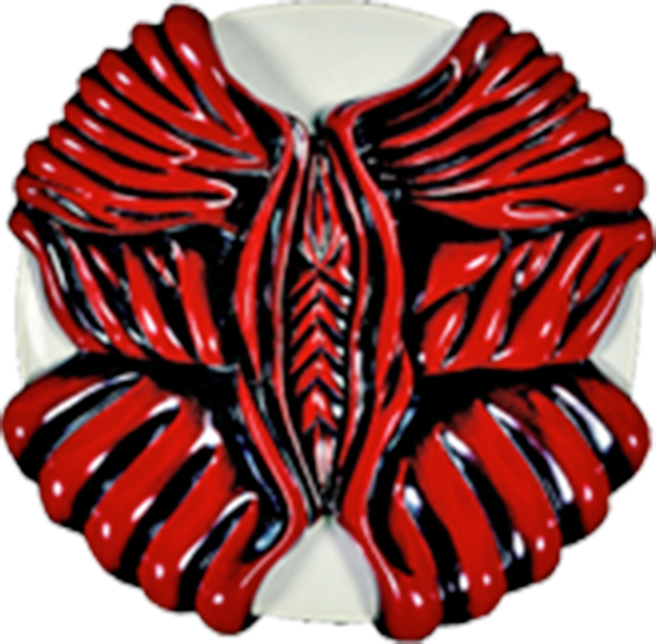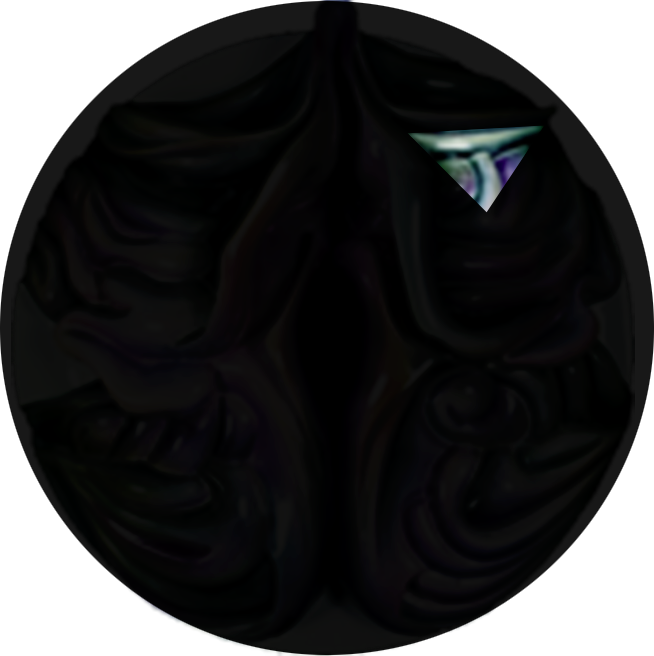Artwork by John McLaren and Chris Cieslik
This puzzle is an homage to, and celebration of, Judy Chicago’s installation work of art, The Dinner Party, with nods to Caryl Churchill’s play Top Girls.
A solver’s first step will likely involve identifying some of the people involved in the dialogues. (Specific clues for each character are identified below). Solvers will likely notice that everyone involved is a historical woman. A combination of the names they identify, the word “Chicago” in the title, which references Judy Chicago (the artist of the installation), and the 39 stops on the subway map will bring them to The Dinner Party.
With that information in hand, solvers will be able to identify the remainder of the women. The specificity of where dialogues are overheard suggests that each historical woman can be mapped to a specific station. “First” in each dialogue maps the first speaker to the station the subway car just passed, and “Second” maps the second speaker to the station the subway car is about to reach.
In addition to that, each subway line traces a commonality between the women on that line. The R line (in green) corresponds to religious leaders and figures historically associated with religion; the women on the S line (in blue) are scientists; the A line (in red) artists; the E line (in purple) educators; the W line (in pink) warriors; the P line (in yellow) political leaders; and the M line (in orange) mononymous (as they are identified in The Dinner Party). The letter of each line is a clue as to what the common element is.
The dialogues and subway lines will allow unambiguous mappings of 26 of the women in The Dinner Party to specific stations, leaving 13 stations unmatched. Those stations, plus Sojourner Truth’s, all have an additional design element on the subway map, which we’ll refer to as a “mask”. (Sojourner Truth is given a dialogue because there were an odd number of non-mask stations, plus that serves as confirmation that the mask stations also map to women in the same way the non-mask stations do).
The remaining 13 women can be mapped to those 13 stations by determining which lines they would be on. For example, Sappho, as a mononymous artist, is on the M and A. Boadaceia, a mononymous warrior queen, is on the M, W, and P. Some line mappings can be ambiguous, so we defaulted to how the women are discussed within the Brooklyn Museum’s fantastic resources and descriptions of each woman.
Once the women have been associated with mask stations, those masks can be applied to the most iconic part of The Dinner Party—the plate at each place setting. Overlaying a given mask on top of the correct plate will reveal a letter. Reading those letters left to right, top to bottom on the subway map will show the answer, ZEPHYR TEACHOUT.
Here is the full list of stops for each line, from west to east.
| P (Politicians) | M (Mononymous) | S (Science) | R (Religion) | A (Art) | E (Education) | W (Warriors) |
|---|---|---|---|---|---|---|
| Elizabeth R. | Sacajawea | Sacajawea | Saint Bridget | Anna van Schurman | Mary Wollstonecraft | Boadaceia |
| Boadaceia | Boadaceia | Caroline Herschel | Fertile Goddess | Hildegarde of Bingen | Elizabeth Blackwell | Amazon |
| Theodora | Theodora | Anna van Schurman | Snake Goddess | Christine de Pisan | Trotula | Judith |
| Eleanor of Aquitaine | Judith | Hildegarde of Bingen | Elizabeth R. | Theodora | Aspasia | Eleanor of Aquitaine |
| Hatshepsut | Amazon | Aspasia | Petronilla de Meath | Artemisia Gentileschi | Sojourner Truth | Kali |
| Isabella d’Este | Aspasia | Trotula | Primordial Goddess | Virginia Woolf | Susan B. Anthony | |
| Trotula | Elizabeth Blackwell | Anne Hutchinson | Sappho | Margaret Sanger | ||
| Sappho | Mary Wollstonecraft | Anna van Schurman | Ethel Smyth | Georgia O’Keeffe | ||
| Marcella | Hypatia | Hildegarde of Bingen | Hrosvitha | Hypatia | ||
| Ishtar | Margaret Sanger | Christine de Pisan | Emily Dickinson | |||
| Hatshepsut | Theodora | Natalie Barney | ||||
| Hypatia | Judith | Georgia O’Keeffe | ||||
| Hrosvitha | Eleanor of Aquitaine | |||||
| Sophia | Kali | |||||
| Kali | Sophia | |||||
| Hrosvitha | ||||||
| Hypatia | ||||||
| Hatshepsut | ||||||
| Ishtar | ||||||
| Marcella |
The complete set of plates and masks is as follows.
| Order | Woman | Plate | Mask | Applied | Letter |
|---|---|---|---|---|---|
| 1 | Saint Bridget |  |  |  | Z |
| 2 | Sappho |  |  |  | E |
| 3 | Sacajawea |  |  |  | P |
| 4 | Boadaceia |  |  |  | H |
| 5 | Trotula |  |  |  | Y |
| 6 | Ethel Smyth |  |  |  | R |
| 7 | Isabella d’Este |  |  |  | T |
| 8 | Judith |  |  |  | E |
| 9 | Eleanor of Aquitaine |  |  |  | A |
| 10 | Hrosvitha |  |  |  | C |
| 11 | Hildegard of Bingen |  |  |  | H |
| 12 | Sojourner Truth |  |  |  | O |
| 13 | Margaret Sanger |  |  |  | U |
| 14 | Georgia O’Keeffe |  |  |  | T |
Notes
We considered including an “equality” or “egalitarian” line to properly celebrate the accomplishments of figures like Sojourner Truth and Susan B Anthony, but it would have been too ambiguous for too many of the historical figures.
For the R line, we mapped that to religious leaders and people who made choices of committing themselves to religion (like becoming a nun). We didn’t count “church-going” or “member of a religion” on the line since then nearly every single person would be on it.
Sacajawea is on the Science line for her contributions to natural history.
Eleanor of Aquitaine is a slight stretch for the warrior line; we included her because she commanded troops in battle during the Crusades, and men who command soldiers traditionally get the warrior treatment (statues, depictions in armor, etc).
We tried to make all of the dialogues pass the Bechdel test, at least as far as subject matter goes. (In our minds discussing the patriarchy doesn’t count as “talking about a man”, but perhaps that’s debatable).
Dialogue clues and references.
Petronilla was the first Irish woman burned at the stake, and her persecution for witchcraft was well ahead of the witch-hunting mania that started sweeping Europe in the late 15th century—hence the comment “my persecution was way ahead of its time.” Petronilla is a tough ID before getting to The Dinner Party, but pretty straightforward once there.
https://www.brooklynmuseum.org/eascfa/dinner_party/place_settings/petronilla_de_meathElizabeth R. was celebrated for defeating the Spanish Armada, and also had a complicated relationship with her cousin, Mary Queen of Scots, whom Elizabeth imprisoned and eventually executed.
https://www.brooklynmuseum.org/eascfa/dinner_party/place_settings/elizabeth_rGentileschi’s most famous work is Judith Slaying Holofernes. It’s too bad the two of them didn’t share a subway line, because I’m sure they would have loved to chat. Caravaggio also painted the same subject.
https://www.brooklynmuseum.org/eascfa/dinner_party/place_settings/artemisia_gentileschihttps://www.uffizi.it/en/artworks/judith-beheading-holofernes
http://www.caravaggio.org/judith-beheading-holofernes.jsp
A section of Woolf’s A Room of One’s Own imagines what Shakespeare’s equally talented sister Judith would have faced had she existed. Spoiler: nothing good.
https://ebooks.adelaide.edu.au/w/woolf/virginia/w91r/index.htmlhttps://en.wikipedia.org/wiki/A_Room_of_One%27s_Own
Anne Hutchinson was a Puritan who, along with her family, got banished from the Massachusetts Bay Colony for holding discussions in her home that were considered heretical.
https://www.brooklynmuseum.org/eascfa/dinner_party/place_settings/anne_hutchinsonAncient and Aboriginal cultures believed the Primordial Goddess to be essentially the life force of the world. Here she is bitter about being written out of the bible and having her work attributed to the Abrahamic God.
https://www.brooklynmuseum.org/eascfa/dinner_party/place_settings/primordial_goddessCaroline Herschel is the only astronomer in The Dinner Party.
https://www.brooklynmuseum.org/eascfa/dinner_party/place_settings/caroline_herschelAnna Van Schurman was a polyglot who knew 14+ languages, including French, German, Dutch, Latin, Hebrew, Italian, Persian, and Greek—all used in her dialogue. All translations courtesy of Google Translate—apologies for any errors.
http://annamariavanschurman.org/about-anna-maria-van-schurman/Socrates and Menexenus discuss Aspasia in Plato’s Menexenus (found here). In that text Plato attributes Pericles’s famous Funeral Oration to being written by Aspasia herself.
The Ancient Greeks were pretty obsessed with Amazons. Fun fact: archaeologists think they were based on the Ancient Scythians, an egalitarian nomadic people. Recommended watching: https://www.youtube.com/watch?v=iYL5CLJ2prA
“Marcella was a Roman noble woman who was canonized, or declared a saint, by the Vatican for her role in founding the Christian monastic system . . . Rather than remarry, as was custom in Roman society, she declared celibacy, devoting her life to God and the study of the Bible. She owned a palace on Aventine Hill . . . ”
It’s maybe a stretch that she would have been able to see the Forum from Aventine Hill, but there were a lot less tall buildings back then, so I’m just going to roll with it.
https://www.brooklynmuseum.org/eascfa/dinner_party/place_settings/marcella“Rituals connected to the worship of Ishtar/Inanna include a Sacred Marriage in which a male ruler is identified with Dumuzi. As the practice was recounted only in literature, it is unclear whether it was purely symbolic or an actual reenactment.”
https://www.brooklynmuseum.org/eascfa/dinner_party/place_settings/ishtarWe went the “actual reenactment” route here, because Ishtar herself would know which of the two it was!
There’s only one pharaoh at the Dinner Party, so this has to be Hatshepsut.
https://www.brooklynmuseum.org/eascfa/dinner_party/place_settings/hatshepsutHypatia studied and taught in Alexandria. (The library referenced here is, of course, the Library of Alexandria). She was murdered, and her work later destroyed, during an anti-intellectualism movement within Christianity at the time.
https://www.brooklynmuseum.org/eascfa/dinner_party/place_settings/hypatiaMore recommended watching: https://www.youtube.com/watch?v=jvWncVbXfJ0
This is a pretty close adaptation of Emily Dickinson’s Because I could not stop for Death.
https://www.poets.org/poetsorg/poem/because-i-could-not-stop-death-479Natalie Barney held weekly salons which she referred to as her “Fridays.” Gertrude Stein and Isadora Duncan attended. (Incidentally, googling some of these terms together will likely get solvers to the Dinner Party site if they’re not there already).
https://www.brooklynmuseum.org/eascfa/dinner_party/place_settings/natalie_barneyThe Snake Goddess was a figure in the ancient Minoan religion on Crete. To her chagrin, Crete is much better known today for being the home of the Minotaur.
https://www.brooklynmuseum.org/eascfa/dinner_party/place_settings/snake_goddessThis is a reference to statues including the Venus of Willendorf and Venus of Hohle Fels, one of the oldest known sculptures of the human form.
https://www.brooklynmuseum.org/eascfa/dinner_party/place_settings/fertile_goddessThe allusion to worshipping will narrow this dialogue to the gods includes in the Dinner Party.
Christine de Pisan’s The Book of the City of Ladies imagines a city where women are respected and considered significant (one could imagine this puzzle taking place in such a city). The book unfolds as a dialogue between her and three allegorical Virtues—Reason, Rectitude, and Justice. Then she just wanted to chill but the Virtues showed back up and made her write a sequel. This bears striking similarities to the story of how we’ve found ourselves constructing the Mystery Hunt for the second time in a three year span . . .
https://history.hanover.edu/courses/excerpts/165pisan.htmlhttps://en.wikipedia.org/wiki/The_Treasure_of_the_City_of_Ladies
Theodora rose up from the bottom of Byzantine society—who considered acting on par with prostitution—to become Empress.
https://www.brooklynmuseum.org/eascfa/dinner_party/place_settings/theodoraSojourner Truth was an enslaved person for the first 30 years of her life.
https://www.brooklynmuseum.org/eascfa/dinner_party/place_settings/sojourner_truthI didn’t set out to make this into a conversation about intersectionality, but then I read the Susan B. Anthony quote, “I will cut off this right arm of mine before I will ever work or demand the ballot for the Negro and not the woman” [ref] and it had to happen. The white American suffragists were terrible to their black counterparts—for instance, they tried to make black women march in the back of the 1913 suffrage parade (Ida B. Wells refused, because she was awesome). And generally distancing themselves from black women to try to get racist white people on their side.
https://www.brooklynmuseum.org/eascfa/dinner_party/place_settings/susan_b_anthonyThe two women were both Quakers—hence the references to Meetings.
Mary Wollstonecraft was Mary Shelley’s mother, and Mary Shelley wrote Frankenstein about an eponymous doctor who creates a creature whom most people refer to as Frankenstein. Mary Wollstonecraft herself was remarkable and brilliant, but not in ways that lent themselves to clues as readily.
https://www.brooklynmuseum.org/eascfa/dinner_party/place_settings/mary_wollstonecraftJust read this: “She was accepted at Geneva Medical College in Geneva, New York where she began her studies in 1847. Despite being snubbed by the local community, referred to by the dean of faculty as an “inconvenience” to male students, and asked not to attend lectures on the male reproductive system, Blackwell persevered. She excelled in all of her studies, from anatomy to material medica, or the study of the origin, preparation, dosage, and administration of drugs. In January 1849, Blackwell graduated first in her class, after which the college closed its doors to women.” WHAT IS WRONG WITH THESE PEOPLE?
https://www.brooklynmuseum.org/eascfa/dinner_party/place_settings/elizabeth_blackwell“In the Gnostic creation story Sophia, seeing God’s creations, desired to make something of her own. The being she formed was her son, Ialdabaoth, who had the face of a lion and the body of a serpent.”
https://www.brooklynmuseum.org/eascfa/dinner_party/place_settings/sophiaKali and Parvati are forms of the same Hindu Goddess.
https://www.brooklynmuseum.org/eascfa/dinner_party/place_settings/kali
